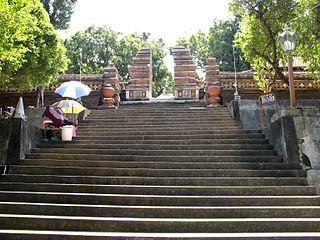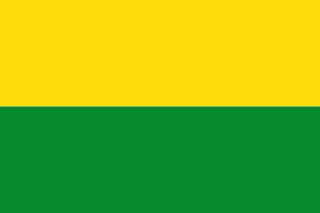
The Sultanate of Mataram was the last major independent Javanese kingdom on the island of Java before it was colonised by the Dutch. It was the dominant political force radiating from the interior of Central Java from the late 16th century until the beginning of the 18th century.

Imogiri is a royal graveyard complex in the Special Region of Yogyakarta, in south-central Java, Indonesia, as well as a subdistrict under the administration of Bantul Regency. Imogiri is a traditional resting place for the royalty of central Java, including many rulers of the Sultanate of Mataram and of the current houses of Surakarta and Yogyakarta Sultanate. The name Imagiri is derived from Sanskrit Himagiri, which means 'mountain of snow'. The latter is another name for Himalaya.

Kraton or keraton is a type of royal palace in Java, Indonesia. Its name is derived from the Javanese ka-ratu-an, meaning residence of the ratu, the traditional honorific title for a monarch. In Java, the palace of a prince is called pura or dalem, while the general word for palace is istana, identical to Malay.

Susuhunan, or in short version Sunan, is a title used by the monarchs of Mataram and then by the hereditary rulers of Surakarta, Indonesia.

The Sultanate of Yogyakarta is a Javanese monarchy in Yogyakarta Special Region, in the Republic of Indonesia. The current head of the sultanate is Hamengkubuwono X.

Hamengkubuwono I, born Raden Mas Sujana, was the first sultan of Yogyakarta. He reigned from 1755 to 1792.

Yogyakarta is the capital city of the Special Region of Yogyakarta in Indonesia, in the south-central part of the island of Java. As the only Indonesian royal city still ruled by a monarchy, Yogyakarta is regarded as an important centre for classical Javanese fine arts and culture such as ballet, batik textiles, drama, literature, music, poetry, silversmithing, visual arts, and wayang puppetry. Renowned as a centre of Indonesian education, Yogyakarta is home to a large student population and dozens of schools and universities, including Gadjah Mada University, the country's largest institute of higher education and one of its most prestigious.

The Treaty of Giyanti was signed and ratified on February 13, 1755, between Prince Mangkubumi, the Dutch East India Company, and Sunan Pakubuwono III along with his allies. The accord officially divided the Sultanate of Mataram between Mangkubumi and Pakubuwono. The name "Giyanti" was taken from the location of the signing of the agreement, namely in Giyanti Village which is now located in Hamlet Kerten, Jantiharjo Village, southeast of Karanganyar, Central Java.

The Principalityof Mangkunegaran is a small Javanese princely state located within the region of Surakarta in Indonesia. It was established in 1757 by Raden Mas Said, when he submitted his army to Pakubuwono III in February, and swore allegiance to the rulers of Surakarta, Yogyakarta, and the Dutch East Indies Company, and was given an appanage of 4000 households.

Kartasura is a district (kecamatan) in Sukoharjo Regency, Central Java, Indonesia. Kartasura is considered Surakarta's satellite city and a junction of highways to Yogyakarta and Semarang. It can be reached within minutes southward of Surakarta's Adisumarmo International Airport.
Pakubuwono II (1711–1749) was the ruler of Mataram.

Pakubuwono XII was the twelfth Susuhunan and the longest ruling of all monarchs in Surakarta history.
Merle Calvin Ricklefs was an American-born Australian scholar of the history and current affairs of Indonesia.

Hamengkubuwono VII was the seventh sultan of Yogyakarta, reigning from 22 December 1877 to 29 January 1921.

Mangkunegara II, also known as Prince Adipati Prangwedana I, Prince Surya Mataram, Prince Surya Mangkubumi, was the second ruler of Mangkunegaran in Java in the eighteenth century who succeeded to the throne of his grandfather, Mangkunegara I. His reign lasted from 1796 to 1835. Mangkunegara II was the son of Crown Prince Arya Prabumijaya I, who was the son of Mangkunegara I. Upon his death in 1835, he was the last male descendant Prince Sambernyawa to be named the Duke of Mangkunegaran.
Kangjeng Gusti Pangeran Adipati Arya Mangkunegara I, also known as Pangeran Sambernyawa, his birth name was Raden Mas Said, established the Puro Mangkunegaran, in Surakarta, Java Island. Thus, he was the first ruler of The Principality of Mangkunegaran.

Surakarta Sunanate is a Javanese monarchy centred in the city of Surakarta, in the province of Central Java, Indonesia.
Pakubuwono I, uncle of Amangkurat III of Mataram was a combatant for the succession of the Mataram dynasty, both as a co-belligerent during the Trunajaya rebellion, and the First Javanese War of Succession (1704–1707).
Amangkurat III was a short-lived susuhunan (ruler) of the Sultanate of Mataram, who reigned 1703–1705.













